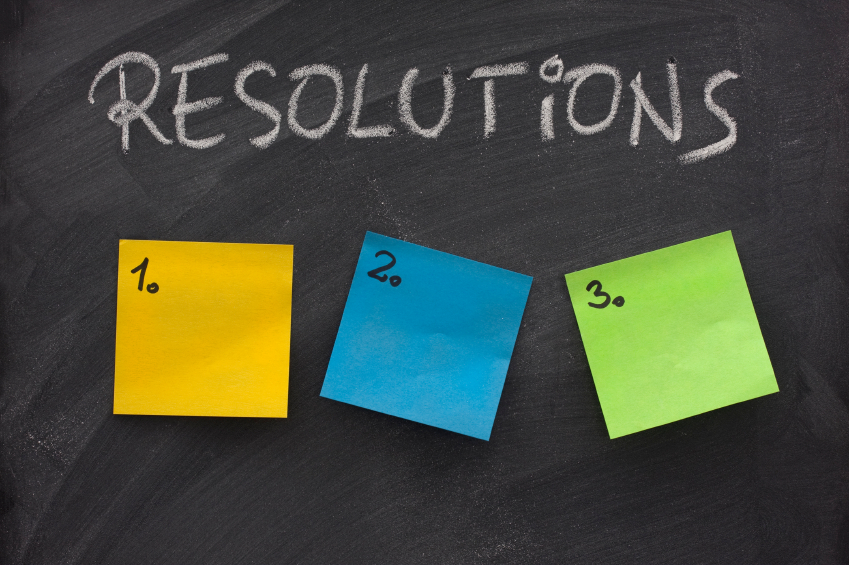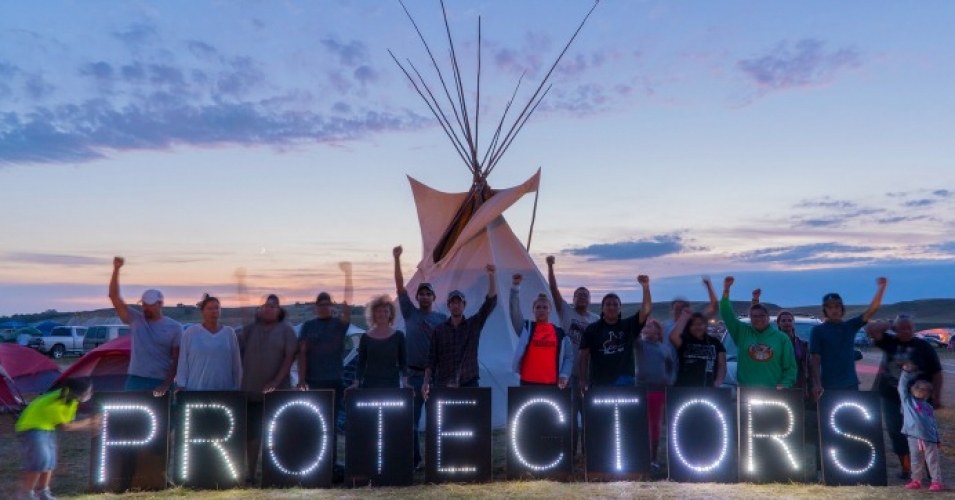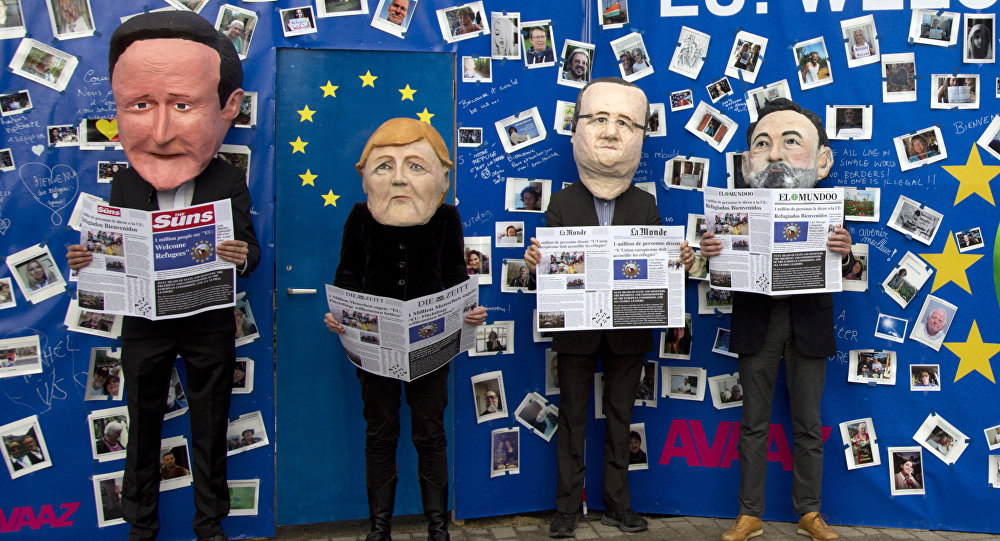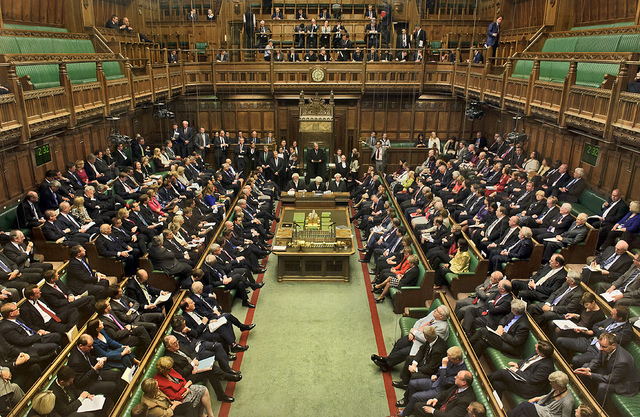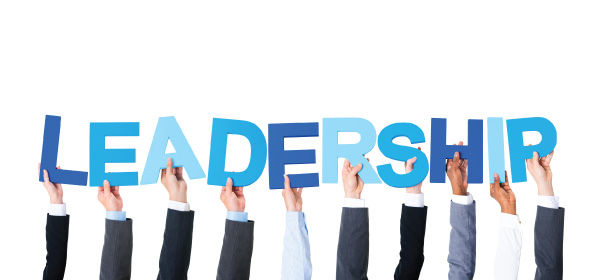While my password is more sophisticated than ‘password’ – you might laugh but a recent article by suggested that’s a very common password – I know I’ve not spent enough time thinking about protecting myself online.
But with news of the hacking of the Clinton campaign, an awareness of how much information that I produce is held in ‘the cloud’, and reading stories like this about a sophisticated attempt to create a fake campaign group to hack the IT systems of organisations like Amnesty who had been raising concerns about workers rights in Qatar. I’ve started to think that I need to consider taking my digital more security more seriously.
As campaigners, we’re often working on issues where there are powerful vested interests that we’re opposing, so making sure that we’re thinking about our data security should be on our to do list. Attending CampaignCon in October it was interesting just how many campaigners at the conference were talking about it as a key concern for the work they’re doing.
For many campaigners, it’s a challenge to get the balance right. We want to collaborate with others which makes platforms like Dropbox and Google Doc invaluable, we need to use social media channels like Twitter and Facebook to get our messages out, and investing in complex cyber security can feel like an unnecessary cost when every penny counts..
It’s easy to think that you only have to worry about your digital security if you’re running some campaign on the arms trade, or in a country with a repressive government. But that’s before you start to investigate the powers that governments have over our data (see the recent Investigatory Powers Bill/Snoopers Charter passed in the UK last) or consider what new laws President Trump might implement and what that would mean for any data held in the ‘cloud’ on a US server.
2017 is the year that cyber and data security need to be every campaigners concern.
If that’s not enough to convince you – at a time when elements of the media are looking for charity scandals making sure that you’re no unwittingly writing a front page story is another reason to revisit those social media permissions.
I’m no expert at how to do this, but I’ve found the following articles really helpful as an introduction to thinking about digital security – but please do add other thoughts in the comment box below.
Step 1 – Start with some light housekeeping – I found this article from Owen Barder really helpful. It’s nothing complicated, but making sure that you’ve got two-step authentication set up, are using a password manager and thinking about where you store key information are some simple and easy steps to take.
Step 2 – Think about encryption – This is a really helpful guide to thinking about how you can tread more lightly when you’re using the internet. Again, nothing that requires lots of technical expertise, but it’s got some really useful suggestions about how to search in private or use secure message platforms like Signal to share.
Step 3 – Consider a digital detox – If you’re concerned about Google actually knowing more about you that your best friend thanks to your search history, use of Google Maps, etc. Have a look at the Digital Detox that Tactical Tech have launched. Again its’s full of really simple and easy steps you can take to take back control of your digital self
Step 4 – Review your campaigns risk – Clearly every campaign comes with a different level of risk attached to it, but this articles from Mobilisation Lab really helpful. I found thinking about this made me consider what information I’m sharing information with on email or who is on those big mailing lists I’m sharing my latest campaign dilemmas with.
Step 5 – Dive in to find out more – The Tactical Tech Collective is a brilliant place for anyone wanting to learn more about digital security – there Security in a Box project while designed for frontline human rights defenders has lots of practical ideas.
Please do use the comments box to share others thoughts, ideas and resources.
What more can I be doing in 2017? My campaigns resolutions for this year
Today will mark the first day in the office for many after the Christmas break. In previous years, I’ve written posts on the resolutions that you can make to be a better campaigners this year (you can read them here) they’re full of useful advice that I’d stand by, but this year I’ve decided to share the 7 things that I’m going to try to do more of as a campaigner in 2017.
2017 feels like it’s going to be important. 2016 was a difficult year, and on many of the issues I care about their is real jeopardy about the progress we’ve made or could make, so now the Christmas break I’m asking myself what more can I be doing in 2017.
We’ve got work to do, so by sharing this I’m doing so for 2 reason – for accountability, in the hope that by writing this it’ll be harder to avoid doing it (please ask me if you see me) and to prompt other to think about what more they plan to do over the next 12 months.
1) Listen more – If I’m taking anything from 2016, it’s that I need to listen more. I’ve been sharing this quote from Sir Craig Oliver with everyone, because I think it’s at the essence of what we so often get wrong in campaigning.
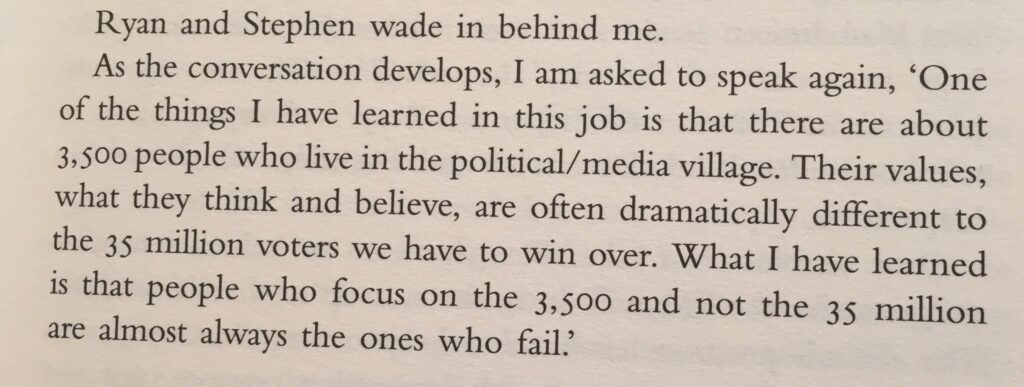
So in 2017, I want to find ways to listen more – to understand what those outside my ‘bubble’ are thinking and to actively seek out different perspectives. There is a temptation to rush from listening to suggesting action or solutions – but I’m not sure that’s going to solve the challenges we face.
So 2017 is a year of listening – I’d welcome practical suggestions of how best to do that. One colleague suggested that we adopt the political party approach of surveying local resident, or perhaps it’s street stalls on High Streets, but whatever solution I come up with I want to be listening more.
2) Share more – I’m convinced that movement generosity is going to be vital if we want to win more. Movement generosity doesn’t mean that we all have to adopt the same approaches or tactics. Far from it, we need to recognise that we’re more effective thanks to campaigns taking insider and outsider approaches, but movement generosity for me is about actively asking how can we collaborate together, and taking time to learn and share from each other.
So in 2017, I want to share more. That’ll be by continuing to write on this blog (and thanks to everyone who has said encouraging things about the blog this year) and make a point of responding to at least one question a week on the E-Campaigning Forum, but I’m also really keen to get out and share with other campaigners – so if you’d like to invite me to speak to your team, department or conference please get in touch. In return, I want to learn from others who are leading and winning campaigns.
3) Read more – I’ve written before that ‘leaders are reader’, so inspired by this article I’m setting myself a goal of reading a few pages everyday, I want to dive into learning more about the Civil Rights Movement something that has long fascinated me, but also learn more about unsung movement builders from history and . I know that reading isn’t for everyone, some people prefer audio books and podcasts (if that’s you here is a list of some podcasts you might want to subscribe to), but however you take in information, I think the principle of actively seeking out new information is a critical one.
4) Get out more – One of the books that I read over Christmas was Gillian Tett’s ‘The Silo Effect‘. I really enjoyed it (and I plan to write more about the lessons we can take from anthropology that she suggests). The book is full that we need to be proactive at getting out of our silos that often emerge in our organisations – perhaps that’s self evident but how often do we fail to do it, accepting that they just exist! This quote at the end of the book is a good challenge;
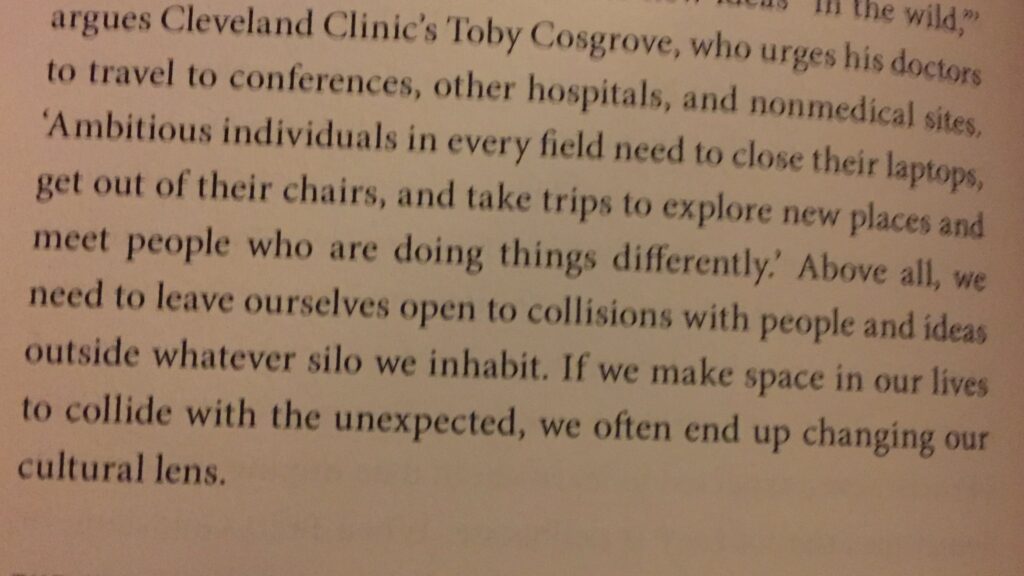
5) Build more – I’m super proud of what Campaign Bootcamp has become since I helped to found it back in 2012 – every few weeks I see a campaign agitating for change and winning from within the Bootcamp community. I believe its a vital part of the campaign infrastructure that we need to ensure we can train, equip and support campaigners to win.
I’ve no doubt that those on the ‘other’ side are reenergised and reinvesting in their infrastructure – so in 2017 I want to explore what I else I can contribute to building so that we’re better equipped to win. I’ve no idea what that is yet, get in touch if you’ve got a good idea.
6) Ask more questions – Campaigners always need to be asking questions (some suggestions here)- what does success look like, do we really need to campaign, who can deliver the change we want. We’ve got scare resources to allocate, and I know that those on the opposite side aren’t planning to take it easy in 2017 – read this for a slightly terrifying view on they think needs to be done in 2017. So I’m going to ask more questions, especially the ‘why’ question – ‘why will doing this help achieve the change we’re looking for’, ‘why do we think that’ – it’s a powerful question.
7) Rest more – with so much to do it’d be easy it’d be easy not to giver permission to rest, but as I’ve written before rest is vital if we’re going to be able to sustain this work for year. Rest doesn’t have to mean sitting around, but taking time to step out of our work to do things that recharge and reenergise us. I know for me that means running (I’m a big ParkRun fan) and tackling some new challenge (a Triathlon for me).
So that’s more of what I’m going to do in 2017 – do use the comments below to let me know what you’re thinking.
Six campaigns that I learnt from in 2016
Let’s be honest. 2016 hasn’t been a great year, and soon it’ll be over! Much of the talk I’ve seen has been dominated by learning from the big political campaigns of the year (which I’ve also written about here)
But a few others campaigns have caught my eye – some because they’ve made the most of the political environment that we’re in here in the UK. Others because I like the tactics or approaches they’re used.
Here are a few that I’d encourage you to check out and learn from;
1. Ratifying the Istanbul Convention – getting a Private Members Bill to pass through Parliament isn’t simple – even when we had the whole of the international development community pushing to enshrine an existing manifesto commitment winning the Turn Up Save Lives campaign wasn’t easy. So IC Change, a volunteer group pushing for the government to adopt the Istanbul Convention, which is the most comprehensive legal framework that exists to tackle violence against women and girls, has done something amazing.
They got their issue on the agenda and through building a coalition, and then working to effectively mobilise SNP MPs to drive support for the Bill, with support from Labour and Conservative MP. Thanks to their efforts they’ve got the Private Members Bill through it’s second reading in the House of Commons. They’ve still got more to do, but it’s inspiring nevertheless, and a example loads of ‘professional’ campaigners could learn from.
2. Ban Microbeads – These small plastic beads commonly found in toothpaste and exfoliating body scrubs which damage the environment. Organisations like Environmental Investigation Agency, Fauna & Flora International, Greenpeace UK, and the Marine Conservation Society have pushed the government to introduce a ban that comes into force at the start of 2017.
By working with MPs on key Parliamentary committees to come out in support (in this campaigns the Environmental Audit Committee) that alongside demonstrating significant public support, meant that it was early announcement under the new Government to introduce a ban. It shows that although the official opposition might not be as functional as many would like to see it, working with effective backbench MPs, who know how to make thing happen, can alongside public pressure can yield results.
3. Child Refugees full disclosure here, some of those I work with at Save the Children won an award for this campaign a few weeks ago, but that doesn’t mean I don’t think the campaign to get the Dubs Amendment, to bring unaccompanied minors to the UK, adopted can’t feature in my list.
Anyone campaigning on refugees in 2016 has been doing so in a headwind of negative media, but this a mix of savvy parliamentary engagement – in this case using the small majority the government has by finding Conservative MPs who opposed the governments position, engaging the House of Lords, working with unusual media allies (in this case the Daily Mail) and targeted campaigning actions delivered results.
If those 3 campaigns have demonstrated how to make change in the current political environment, the next 2 have demonstrated some smart use of tactics;
4. Spendrise – I’ve written about this site before, and while it’s only got going this year, I really like the simple concept which gets those who want to see change to pledge to spend money with a particular retailer if they take action – check out www.redcupsecret.com to see how it works for getting Starbucks to ensure it’s famous red cups are recyclable. During a time when people are increasingly asking questions about the role of clicktivism I think the concept potentially has millage.
5. www.schoolcuts.org.uk – I’ve not seen a better website this year which allows you to look at the impact of the current governments cuts on a particular subject. Developed by the NUT and ATL, the site lets you look at how the reduction in education spending will impact your local schools, and then has a really nice user experience to get you to take action. The campaign might not have (yet) succeeded but the personalisation could help to unleash an army of parental activist.
Finally, a campaign that has inspired from afar;
6. #NoDAPL #StandingRock #WaterProtectors – led by the Standing Rock Sioux tribe, thousands gathered in North Dakota in an unprecedented action, communicating using Facebook Live, building support and winning (for now). It builds on the success of the Stop Keystone XL campaign which I wrote about here. Both reminders that even when it seems unlikely we can win.
Disagree with the result – but you can learn from Trump and Vote Leave campaigns
2016 hasn’t been a great year (and at the end of it I’d encourage everyone to read this about how to make sure we’re looking after ourselves as campaigners) – but I’m convinced that there is learning for campaigners to take from any campaign – even if you passionately disagree with the outcome.
Let’s start with Trump
- Don’t underestimate what those on the ground are telling you – in a world of insight and data it’s easy to trust the model, but the unexpected victory of Donald Trump in November has led some to suggests that the Clinton ignored those on the ground who saw the threat coming – so much so they might have actually been mobilising people to vote for ‘The Donald’
- Everyone get’s excited about Twitter but Facebook is where it’s at – we might have all become obsessed with Trump’s tweets, but behind that Donald Trump was building a Facebook operation to target those who he needed to mobilise, but no one else could see those posts. It was the same in Australia, where the unseen Facebook campaign helped swing the election, or Brexit where the Leave campaign ‘served about one billion targeted digital adverts, mostly via Facebook’.
- Get creative about how you acquire the data you need – For Clinton it was via concerts to collect data to help mobilise key voter groups, for the Leave Campaign it was a competition to win £50m if you could predict the results of the European Football Championships. Both might be seen as gimmicks but they helped to collect data the campaigns needed.
- But if you are going to respond with protest have a clear theory of change – as this article there is both a science and an art behind successful protests. Want to get the low-down on what makes a protest work then these 10 social science insights are a good place to start
Don’t overlook what Bernie Sanders built
While he might have lost the Democrat Primary his organising model is likely to echo into future elections (this is a good summary and you should 100% read this).
- Make the most of armchair volunteers – Bernie didn’t just ask people to get involved in contacting voters, but his distributed organising model made the most of armchair volunteers – individuals who are happy to spend hours at home inputting data or staffing virtual help desks.
- Build a model that can scale – Sanders started as the underdog, he didn’t have lots of money or people so outside the first few states he had to build a distributed model that could scale. The principles can be adapted by other campaigning organisations as this Net Change report shows.
- Harness the power of mobile – If 2008 was the email election and 2012 was the Twitter election, I’m not sure what 2016 should be called, but the way that Bernie used mobile to engage with voters might be one of the lasting legacies.
Remember Brexit?
I wrote this shortly after the vote in June. I think lots of the insight still stands but 6 months later there are an abundance of people writing from inside the campaigns on what worked and didn’t work.
- Focus beyond the Westminster Bubble – I really enjoyed Unleashing Demons by former No 10 Communications chief Sir Craig Oliver. Although he was on the losing side this insight seems pertinent to all campaigners;

- Message discipline wins – Like it or not, but Vote Leave focused on a tight message about take back control, with the now dodgy £350m statistic at the heart of it. As Tom Waterhouse who worked on the Leave campaign writes they managed to get their message to stick in a way that the Remain campaign didn’t, and while the Remain campaign tried to focus on myth-busting, Jon Quinn suggests it’s an increasingly ineffective tool.
- Street stalls don’t win you elections – while they can be good for visibility, the Leave campaign focused on building an impressive operation to make sure they were targeting the right people rather than high profile but ultimately ineffective approaches. From gathering emails from those who fancied winning £50m from predicting the election, to building their own technology to gather all the data they were collecting, to targeted mailings. As a result of testing, Leave knew who it needed to mobilise on June 23rd.
If you want more on the Referendum here are good insights from the Leave and Remain sides.
There is hope in unusual places – I’ve already shared learning from the Australian election, but this story of how Get Up focused it’s resources to impact where it really mattered.
But finally, let’s not forget that US Elections lead to some of the best campaign videos – this is one of my favourites.
“You want to give me a good send-off? Go vote!” —@POTUS: https://t.co/tTgeqy51PU pic.twitter.com/ESQkLV2yaJ
— Hillary Clinton (@HillaryClinton) October 12, 2016
Books I've enjoyed this year – some recommendations for campaigners
It’s the time of year when people are looking for ideas for Christmas gifts. So here are a few recommendations from things I’ve read over the last 12 months for campaigners looking to add something else to under the tree.
How Change Happens – Duncan Green’s long trailed book answers a critical question that all campaigners need to grapple with – how does change happen. It’s a really good read, and as I wrote here I really enjoyed some of the challenges that Duncan puts out to those of us who work in campaigning. Change doesn’t happen in a linear way, and we need to adjust our thinking and approach to respond to this.
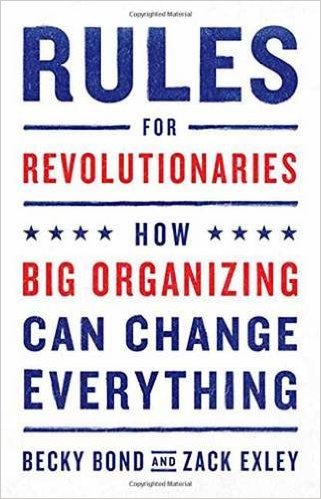 Rules for Revolutionaries: How Big Organizing Can Change Everything – I need to do a bulk purchase of this to pass onto my team. It’s simply a brilliant book written by Becky Bond and Zack Exley who were the brains behind the ‘distributed organising approach’ that took Bernie Sanders so far in the Democratic primary in the US .
Rules for Revolutionaries: How Big Organizing Can Change Everything – I need to do a bulk purchase of this to pass onto my team. It’s simply a brilliant book written by Becky Bond and Zack Exley who were the brains behind the ‘distributed organising approach’ that took Bernie Sanders so far in the Democratic primary in the US .
It’s short, at around 150 pages, unpacking how the approach was so successful with lots of stories to make the pages wizz by. Bernie Sanders clearly built something very unique so the 22 rules in this book. It’s oozing with wisdom and insight. A MUST READ.
Blueprint for Revolution – I loved this from Srdja Popvic, the Serbian activist who led the movement to overthrow Slobodan Milošević and has shared his skills around the world since. It’s part autobiography, but also part playbook for anyone involved in campaigning. It’s an easy and enjoyable read, with Popvic mixing a range of stories from his personal experience with lessons from history. My review of the book is here.
The Inevitable – this isn’t a book about campaigning, but the themes that Kevin Kelly explores in his book which looks at the themes which will shape technology over the next 30 years are totally relevant to anyone who wants to. I put the book down feeling a mixture of emotions, excited about what the future will look like for campaigning but also daunted about what the trends driving us towards. This is one of the best books I’ve come across to looking into the future. It’s not an easy read but a worthwhile read.
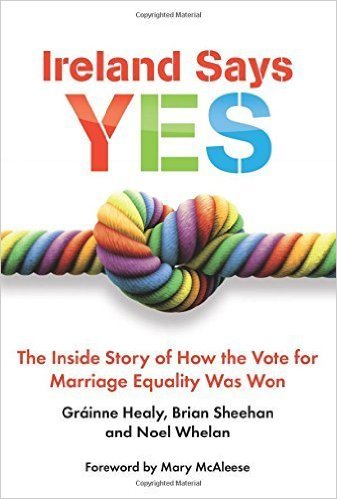 Ireland says Yes: The Inside Story of How the Vote for Marriage Equality Was Won – I had the privilege of hosting Gráinne Healy at the Bond Conference in March. Her insider account of the campaign for equal marriage in Ireland is brilliant.
Ireland says Yes: The Inside Story of How the Vote for Marriage Equality Was Won – I had the privilege of hosting Gráinne Healy at the Bond Conference in March. Her insider account of the campaign for equal marriage in Ireland is brilliant.
As I said to CharityComms – it’s a page-turning account of a referendum campaign which successfully integrated brilliant messaging, powerful messengers and creative tactics to win.
If the story of the Irish referendum inspires you, I’d also really recommend Winning Marriage: The Inside Story of How Same-Sex Couples Took on the Politicians and Pundit sand Won which focuses on the equal marriage campaign in the US.
Looking ahead, I’m also super excited about 2 books coming out in early 2017. The Myth Gap: What Happens When Evidence and Arguments Aren’t Enough by Alex Evans and Analytic Activism: Digital Listening and the New Political Strategy by David Karpf.
They’re definitely on my wish list for early 2017. What else should I be adding?
Looking ahead – some questions for campaigners
Back in 2014, at the start of my time at Bond I wrote this post on the 4 trends driving campaigns. I was trying to reflect on the big themes that I anticipated would shape campaigning for the networks members (and beyond) in the coming years.
I finished at Bond last week, as I’m moving on to lead the Mobilisation Team at Save the Children UK – I can’t wait to get started working with the team to continue to build a movement to speak out vital issues like child refugees, Yemen and early years education in the UK.
(It’ll also mean that I’ll be putting a pause of blogging until after Christmas so I can focus my energies of getting settled into my new role – but that’s the housekeeping notices out of the way!)
But as I finish my time at Bond after 2+ years, I’ve been reflecting back on those trends – I think they’re all still relevant for campaigning organisations to grapple with – but I’ve also been struck that there are some core questions that campaigns teams need to be discussing.
They’re drawn from some of the articles and reports I’ve been reading, and conversations I’ve been fortunate to have with campaign leaders from the UK and beyond over the last few months.
1. Is our approach Managerial or Networked?
Managerial campaigns are more centralised and controlled. With that can come the opportunities to deliver big ‘set piece’ moment, but managerial campaigns can struggle to respond with the agility that can be expected in the age of instant communications.
Networked campaigns are distributed – they haven’t necessarily given away all control, for example overall political strategy might be held at the centre, but much decision making is pushed downwards, and their is autonomy to decide what is most appropriate at a local level.
Much of my thinking of this is drawn from the Networked Change report I wrote about here.
2. Are we focusing on Mobilising or Organising?
Mobilising is building membership and focusing on maximising the number of actions that can be taken. It can be an effective at demonstrating breadth of support, but can lead to a constant need to invest in recruiting.
Organising is about focusing on building power and leadership with communities. Demonstrating depth of support and building leaders who can engage others.
Much of my thinking here is drawn from the work of Hahrie Han who I help to host when she visited London in March – helpfully summarised by Jim Coe here.
3. Do we have Convening Power or Organising Power?
Convening power is the ability to leverage identity and networks to bring leaders together- for example the ability to get lots of senior leaders to sign onto a letter or a range of organisation to ‘back’ your campaign.
Mobilising power is being able to draw on a base of supporters to back your policy demands and willing to engage in conflict with organised opposition – the ability to bring people out to actively support your issue.
My thinking on this is drawn from a fascinating set of essays on New Models of Change from a US based think-tank New America. This case study on the involvement of US evangelicals in pushing climate legislation is a perfect example of what happens if you only have convening power.
4. Are we just harnessing ‘Stop Energy’ or ‘Go Energy’?
Stop Energy is the ability to use tools to channel ‘moment-specific opposition, expressions of dissent, reaction’ on a topic or issue. It’s something lots of campaigns are effective at doing, you see it in emails asking you to ‘sign the petition to stop this event happening’ for example.
Go Energy is the ability to use tools to help people work towards a ‘strategic action over time’ to help people to organise towards a particular goal or outcome.
My thinking on this was prompted by this essay from Kathryn Perera, which draws on the work of Micah Sifry.
5. Do we lead with facts or stories?
Sharing facts is what many campaigns are comfortable with doing, but we all know that they’re rarely the thing that effectively shifts peoples opinions. As this post on Grammar Schools reminds us we can have all the evidence proving that they increase inequality but that doesn’t appear to shift public opinion.
Stories and narratives can be powerful at motivating ongoing action, especially when they place those at the grassroots at the centre of the action, as Jonah Sachs says making them the heroes of what’s happening.
My thinking on this has been provoked by reflecting on the different approaches of the Remain and Leave campaigns during the Brexit vote.
6. Are we recognising we are interconnected to other issues?
Being interconnected recognises that we are campaigning in a complex environment, acknowledging and providing solidarity with that the issues you’re working on are linked to other causes.
My thinking of this was prompted by the findings of Networked Change and seeing how many environmental organisations have been actively expressing solidarity with those campaigning for racial justice, but with Brexit and the election of Donald Trump it seems even more important than before.
Email your MP – where next?
It’s a truth, almost universally acknowledged, that MPs don’t like ‘email your MP’ petitions.Listen to MPs talk to campaigners, and they’ll tell you they find the annoying and a burden on precious staff time, but they’re a staple in most campaigning toolkits.
Most MPs will tell you that the volume of emails means it can be hard to distinguished between the signal and the noise? Don’t believe that? While this image is a little out of date (it’s from ECF2014) it was Stella Creasy sharing what, on average, comes into her inbox during a week in Parliament;
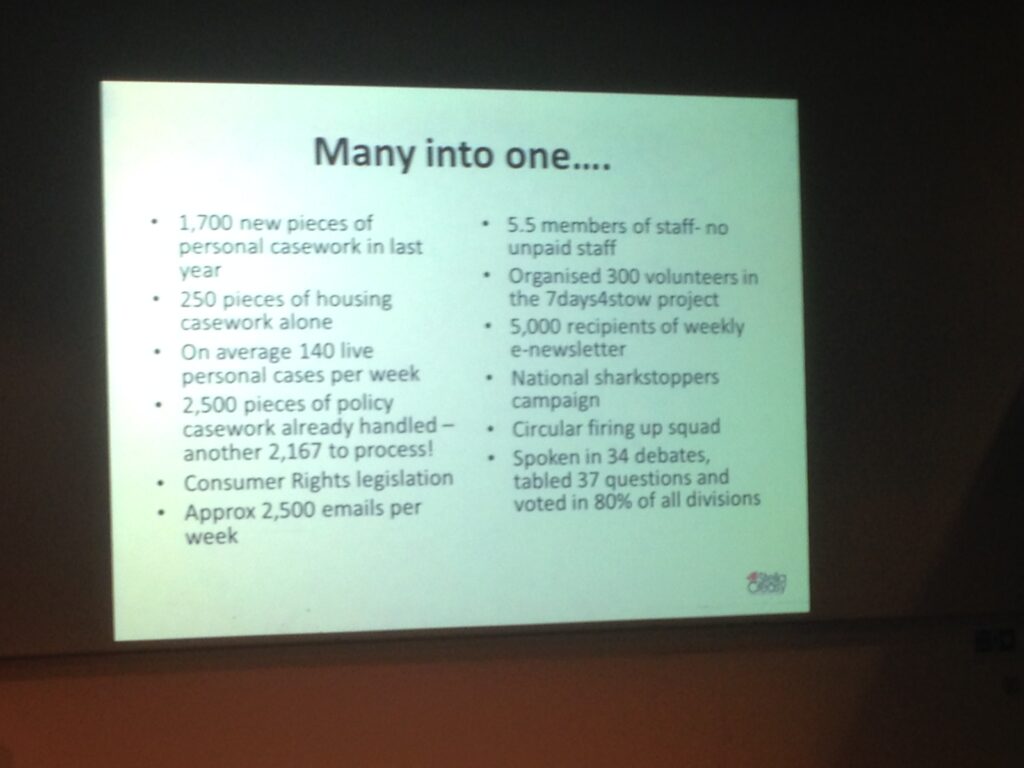
Now, I’m not suggesting that we should head calls from some MPs to stop petitioning them – they’re our elected officials so we should petition them. I’m also realistic that any ‘cross Parliament’ solution is unlikely to be adopted – MPs they say, have to be seen as 650 small businesses, so rarely do they all-adopt the same technology, unless they’re told to.
Plus I’m not going to dive into a debate about the quality of some campaigns, except to add that some email to MP campaigns don’t appear to have thought about what the theory of change is – and that has an impact all of us (all campaigners should read this on what makes an effective petition).
So what could replace them in our toolkit? Or if not replace improve how we use them?
1. Phone calls – Unlike the United States we don’t have much of a culture of calling your elected official – perhaps it’ll catch on? Even then it will still be likely to frustrate MPs as much as emails do as they don’t have the staff capacity to deal with the calls, or effective mechanisms to collect the information from them.
2. Parliament petition site – I’ve suggested before that the frustration of MPs could be channelled towards suggesting that they’ll only accept petitions via the official Parliament petition site. While the site has been improved, it still has lots of limitations – not least when it comes to supporter data which is held just by Parliament, that it’s a closed site (so it can’t be embedded on another website) and doesn’t allow for any personalisation by the signer.
3. Focus on a specific MP rather than all MPs – At the NCVO Campaigning Conference, Jess Phillips MP suggested that one of the most effective petitions she’d seen during her time in Parliament had been the change.org petition on the Tampon Tax, which had worked directly with Paula Sherriff MP to help to provide her with the evidence of support for the issue. Strikes me that most issues can find a Parliamentary champion or two, so perhaps this is a way forward?
4. Require your own message – MPs complain that too many emails are identikit, but while many of us try to persuade supporters to personalise the messages they send, have we tested what the drop off would be if we required supporters to come up with their own subject lines, or add in a reason why your signing? It wouldn’t solve the volume question, but could mean that MPs couldn’t accuse of us of just sending ‘identikit’ messages.
5. Better integration with casework software – many MPs who have large amounts of casework use software to track the requests that are coming in from constituents. How many of us are looking to see how we can incorporate our actions and messages into these?
6. Email to letter – Given I have an app on my phone that can turn my photos into a personalised postcard that can be sent in the post to a friend, could the same technology be developed to turn my email to an MP into a letter. It’d place a cost on the organisation behind the campaign, but it’d present the opportunity for delivery via another channel.
7. Snapchat – I can’t pretend to understand Snapchat – which probably means most MPs won’t either) but opportunities do new communication channels like Snapchat or WhatsApp provide new ways to communicate with MPs?
8. Bots – Florian from MoreOnion wonders here if the rise in the use of AI means that we’ll be able to design bots that will be able to automatically capture and engage in a campaign action – could that help MPs respond to our requests.
I’m sure other solutions exist , as well as examples of where petitions are having an impact – in the same presentations that I took that image from Stella Creasy talked about the importance of ensuring a petition is part of wider advocacy strategy – she specifically mentioned Friends of the Earth Bee campaign.
Either way what strikes me from the list above is that organisations have to be prepared to adapt and change rather than just defaulting to ’email your MP’. I look forward to hearing thoughts from others of how we make this tool work to have the maximum impact.
Leadership in campaigning – some thoughts
The further I’ve gone in my career the more I’ve been thinking about what leadership in campaigning looks like and the more I’ve found that there aren’t easy answers out there.
So it was great to be asked by Jim Coe to chat with him about some of my thoughts about leadership and campaigning a few months ago. You can listen to the whole podcast here, but preparing to speak with Jim and thinking about the topic has got me thinking.
There is of course a legal and project management element to campaign leadership – it’s important to know about the latest regulations from the Charity Commission, or how to manage a budget, or ensure good external stakeholder relations. But what I don’t find is writing about how to lead teams of campaigners or campaigns.
On leadership, I’ve been really inspired and informed by the writing of Margaret Wheatley, who wrote this excellent and very accessible paper (it’s only 6 pages long) on ‘host leadership’ a few years ago.
Most of us aren’t going to the be the ‘heroes’ who are the ‘face’ of a campaign or a cause – indeed I think there is a whole post to write about if the model of campaigns with a ‘figurehead’ leader is largely redundant.
But for those of us in leadership roles in campaigning it’s a really important paper to read, because it speaks to the challenge of managing and leading talented individuals who are hungry to change the world, working in complex (and often changing) situations where plans evolve and the external environment can shift at a moments notice.
So I’m really putting some thoughts out here, not to present them as a ‘blueprint’ but to spark a conversation amongst others in leadership roles in campaigning.
As a campaign leader I’ve found the following important;
1 – Help those around you make sense of the story – Helping others to step back from the now and understand how does a specific win or campaign fit into the bigger picture of the change that you’re going to achieve, how does that win further the cause that you’re all working for.
2 – Intentionally invest in others – This isn’t unique to leading campaigners, but there can be so much ‘doing’ in campaigning that it’s hard to find the time to pause and make sure people are investing in their personal development. What that looks like will be different for different people – some will appreciate being encouraged to find a mentor, others will need a recommendation of a good book to read, but holding the space for others to flourish by investing time in them means we continue to cultivate generations of campaigners.
3 – Model what you’d expect from others – Let’s be honest, burnout is a huge problem for campaigners. One of the hardest things that I find about leading a team is trying to model what the right balance looks like – I’m a workaholic. I know I don’t expect others to be ‘always on’ but often in campaigning its hard to switch off. It’s easy to tell others to do it, but as I’ve stepped into leadership I’ve become more and more aware that unless you ‘walk the walk’ you can’t expect to ‘talk the talk’.
4 – Understand my privilege – I was fortunate to spend a day thinking about power and privilege early in my career – it was insightful in helping me to think about this and challenge my approaches. I’ve still a lot to learn, but those of us in leadership need to be aware of our privilege. This from NEON is a really helpful resource to start to think about this.
5 – Recognise weaknesses – None of us are good at everything – so as much as we might not like to admit it – we need to be vulnerable to others including those we lead about what we’re not good at. I’ve found that people respect you for it.
6 – Assemble a team around you – Some of those I most admire in campaigning are individuals like Ralph Abernathy and Bayard Rustin they’re not household names, but they’re those who stood around Martin Luther King as he ‘led’ the civil rights movement. The one question I often encourage people to ask when they’re applying for another job is to ask their potential future line manager ‘who do they go to when they don’t have the answer’. Why? Because the best leaders I’ve ever worked with have had people around them to council and challenge them – leaders who think they know it all invariably fail.
7 – Create the space to be curious and ask ‘why’ – Like taking time out or investing in development, the space for evaluation is often lost in our busyness. Evaluation is more than just completing the indicators form at the end of a project. Campaign leaders need to be hosting those around them to ask some of the questions that Duncan Green was encouraging us to think about – to be curious about why change is happening or share rumours.
8 – Pass it on – I’ve written before about the importance of mentoring and coaching – which means those of us in leadership need to be generous in offering to do just that to those who are a step or two back in their campaign leadership journey. Not sure where to start Campaign Bootcamp has a mentoring scheme that’s always looking for people.
I’ve very much written this to start to kick off a conversation about leadership in campaigning, so please do comment below on what else I’ve missed.
Making change happen – reflections for campaigners
One of the joys of my job is I get to go off to talks to listen to interesting people. Last week I got to enjoy thought provoking hour with Duncan Green.
Duncan is Strategic Adviser at Oxfam GB – basically from what I can tell he employed to write + say interesting and proactive things to help make NGOs and others involved in international development better. If you’ve not come across his writing before I’d strongly recommend his website ‘From Poverty to Power’.
Duncan is about to release a new book ‘How Change Happens‘ and I’d recommend going along to one of the many lectures and talks he’s giving over the next few months – it’s full of lots of useful content.
This session was especially useful as it was focused on those those involved in running and leading global campaigns, as it was part of a fascinating workshop hosted by Save the Children International and World Vision International sharing what they’d learnt from campaigning on the MDGs (and on that topic this learning from Water Aid about there work on pushing on the post-2015 agenda is also excellent).
The session was also packed full of useful insight, and big credit to both organisations to actively looking to share what they’ve found has worked and not worked from the campaigning they’ve been involved in over the last 5+ years.
But here are a few things from Duncan that got me thinking about our approach to understanding change.
How change happens? It’s complicated.
Campaigning isn’t like making a cake – we can’t just repeatedly add the same ingredients, mix them together, put in the oven, and get the same cake time and time again. Instead change is complex, ‘non-linear’, messy and involves multiple actors. Frankly its complicated!
To reflect this campaigners need to grapple with what changes a system, to reflect on the role of critical junctures in driving change (see some of my thoughts on preparing for crisis’s here) and recognise that causality is uncertain. I was struck that some of the models in Pathways of Change are really helpful here.
But our traditional planning approaches don’t accommodate complexity.
It’s not often Mike Tyson gets quoted in a campaigning presentation but his quote ‘Everyone has a plan ’till they get punched in the mouth’ is a 21st century take on the ‘No strategy survives first contact with the enemy’ quote. We need to accept that our strategies aren’t up to incorporating the complexity of the challenges we work on.
Instead Duncan suggests that when we to have two types of theories of change – Theories of Change which look at how we think the system is going to be changing even without our interventions, and a Theory of Action which focus on what we hope the impact will be of the interventions that we plan to make. (see more here)
So we need to start to think differently.
As change makers we need to start to think/feel/work in a different way. We need to nurture an inherent curiosity about how change happens, to listen to gossip which can often help us make sense of what’s happening, to learn to embrace uncertainty, and be reflective to recognise our own prejudices and power. In short, we need to ‘learn to dance with the system’ (this draws on the work of Donella Meadows who’s paper on this I’d recommend reading)
Open ourselves to unusual suspects and voices.
To dance with the system we need to look out for those who are already dancing in the system – that might be more ‘junior’ staff in our offices who are actually more ‘in touch’ with with new trends or approaches, to actively get ourselves out of the ‘thought bubbles’ that are so easily to inhabit, or through different ways of seeing he world, for example Duncan ask why do we draw so much from the scientific/econometric approaches in how we try to evaluate advocacy – could we learn as much from history, sociology or social anthropology?
Duncan’s book is published at the end of the month and available at all good bookshops – I’ve pre-ordered my copy.
How to build strong + people powered movements for social change
Thanks to Facebook Memories I’ve rediscovered these ten positive, proactive steps to build a strong, human movements which I first shared a few years ago.
They were written by David Cohen, co-founder of The Advocacy Institute (who died late last year). I find them challenging, inspiring and deeply practical. I’d encourage anyone involved in movement building to journey with them and trying to reflect on them.
They’re wise words for anyone in the business of trying to achieve social change.
1. Remember where you come from, that you are part of something larger. Celebrate your origins and roots.
2. Listen to the insights and experience of people who are affected by the issues and participate in the efforts. They are the real experts – amplify their voices. Keep professional experts “on tap, not on top.”
3. Keep balance in your work and personal life. Work hard, yes. Meet responsibilities, yes. Make an extra effort, yes. But also add humor and rest. Avoid pessimism and martyrdom.
4. Recognise human frailty and accept it. Set the example by not holding yourself – or others – to rigid or impossible standards that drain the organisation’s energy.
5. Motivate others by sharing responsibility, paying attention to others, and encouraging those who make the extra effort. Give praise when it is merited.
6. Model behavior, or set a good example, by fostering cooperation, sharing information with others, and encouraging others’ leadership. Don’t dominate. Leave space for others to share their knowledge and skills.
7. Insist on a calm approach to solving problems. Set real deadlines. Avoid a crisis mentality.
8. Share credit generously within the organisation, sector, and among allies.
9. Be equally civil to those who share your views or tactics, and those who do not. Agree to disagree and do so without personalising disagreements.
10. Recognise that there are incremental steps in the advocacy journey. Celebrate how far a group has come and what it means to the lives of people. New experiences – like meeting with a bureaucrat, politician, or editor – are as much a success as winning a favourable policy. They build confidence and empowerment that, in many ways, are the most profound and lasting changes. Saver them.
Interestingly these positive statements were based on a list written by a 1980s environmental organiser, Byron Kennard entitled ‘Ten Ways to Kill a Citizen Movement‘ – its also worth a read!

